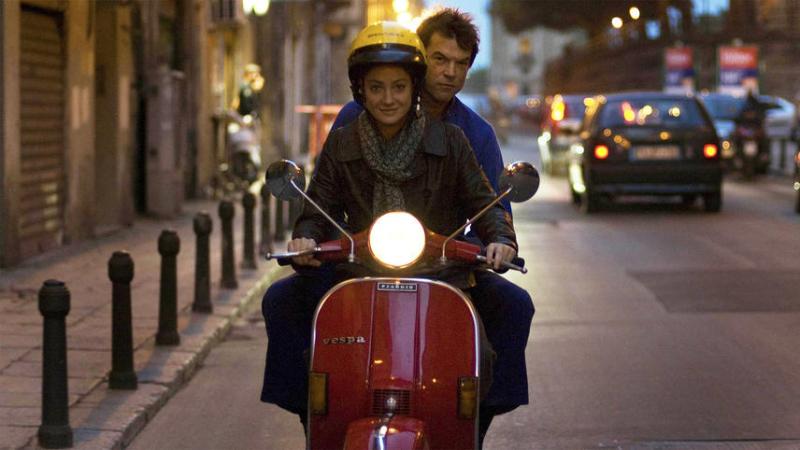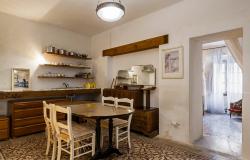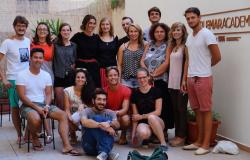Palermo Shooting premiered in 2008, directed by the German Wim Wenders, famous for Paris, Texas and the Buena Vista Social Club. Although it never reached the same critical heights as these previous works, it is nonetheless an evocative portrayal of Sicily’s capital. The ‘shooting’ in question has nothing to do with mafia violence, but is a reference to the profession of the lead character, Finn Gilbert (played by the rock musician Campino), who is a renowned photographer. It is not the first time Wenders has made a European city a central protagonist in a film; he did something similar with the eponymously titled Lisbon Story.
The opening scene fades between monochromatic shots inside Palermo’s Capuchin Crypt, lighting the macabre faces of the mummified corpses found in the wall niches. This sets the mood for a movie that deals with themes of life, fulfilment and attitudes towards death. The initial part of the film takes place in Dusseldorf, where Finn is pursuing a lucrative career path as a fashion photographer, moving away from his more cutting-edge artistic efforts. His sleep-deprived life revolves around bars, nightclubs and insomniac drives around the city. During one of these drives, whilst attempting to photograph from the car, he almost dies. We see the spectral vision of a hooded face as we imagine the potential crash that could have ensued.

Lead character Finn Gilbert played by German singer Campino
Wandering through river-carved pasture land, perhaps in a dream, Finn spots a passing barge named after Palermo, a city he then has to visit in order to finish the photo shoot of a pregnant Milla Jovovich. Instead of returning immediately, he is so captured by Palermo that he delays his departure, even ignoring his constantly ringing mobile phone. Finn takes to the streets with camera in hand, listening to his headphones. Unsurprisingly, as Wenders is a former music video director, there is a vibrant and atmospheric sound track including Nick Cave, Portishead, The Velvet Underground and Calexico, which accompanies Gilbert’s wanderings around the city. He meanders through the Vucciria, one of Palermo’s iconic markets. The cacophony of the vendors’ cries and the melee of people contrast markedly with the self-absorbed photographer.
He finds himself, both literally and metaphorically at a crossroads, specifically the Quattro Canti, the Baroque heart of Palermo which splits the city into four quarters. The two main thoroughfares dissect at this point: Via Maqueda and Corso Vittorio Emanuele. The current layout dates back to the early seventeenth century and is a display of Spanish colonial power. Each of the four curved side buildings are fronted with a fountain, adorned with a statue representing one of the seasons. Above are marble figures of Spanish kings or the saintly protectors of the city, including the famed St. Agata. Finn falls asleep on a fountain edge, remarkable given Palermo’s traffic. In his dream-like state, a hooded archer appears from one of the Baroque windows high above and an arrow narrowly misses him, dissolving on impact with the nearby statue.

Quattro Canti, Palermo
Shaken by these events, our protagonist spends the evening drinking and crying into the night. Still unsure how to proceed with his life, the following day is equally aimless. We see him emerge from the Kalsa district, the old Moorish quarter, named from the Arabic Al-Khalisa (the purest). It is home to the ruined church of Santa Maria dello Spasimo, an institution that once commissioned a Raphael painting, but now plays host to summertime concerts.
In another semi-derelict building nearby, still clinging to its faded frescos, Finn first encounters the art restorer, Flavia, played by the Italian actress and Cannes Film Festival jurist, Giovanna Mezzogiorno. Initially, she is reluctant to engage with this rather odd German photographer. Spurned by her refusal to go to a caffè, Gilbert lunches alone at the iconic Shanghai Trattoria, just off Piazza Caracciolo. The Chinese awning and décor have little to do with the food, which is very Sicilian. Peter Robb, the author of Midnight in Sicily, also ate there and was happy to hear the proprietor read his own poetry whilst he dined on the wonderful stuffed squid.

Giovanna Mezzogiorno in a scene from the movie
The ghostly hooded figure continues to haunt Finn on his wanderings through Palermo. Escaping to the heights of Monte Pellegrino - the brooding mountain looming over the city which so enchanted Finn’s eighteenth century compatriot, Johann Wolfgang Goethe - the photographer yet again finds himself the target of a spectral arrow.
Death haunts him in a more metaphorical manner when he returns to the streets and enters the Palazzo Abatellis, a rather severe Catalan-Gothic palace once belonging to the port master and once a convent. It is now the regional gallery and home to a fresco entitled, The Triumph of Death. It is on this painting that the fictional restorer, Flavia, has been commissioned to work. She explains the complex image to a bewildered Gilbert. At the centre of the fresco is a skeletal horse being ridden by death itself. Other depictions include Pope Nicholas, the archbishop of Palermo, the Antipope and King Alfonso of Naples; in contrast, we also see the poor, supposedly begging for death to release them from their misery. Although the work is by an anonymous local painter, he has artfully included himself by means of a small self-portrait.

"The Triumph of Death" fresco, author unknown, c. 1446
Flavia takes pity on Finn and allows him to stay in her garret apartment which actually forms part of the Porta Felice at the seaward end of Corso Vittorio Emanuele. This is one of the old city gates, styled from Renaissance to Baroque, adorned with eagles alluding to Spanish heraldry. The gate can be reached by strolling along the Mura Catene, the wall that used to house the chains that closed the harbour. This is also a good opportunity to see the Palazzo Lanza Tomasi, the last residence of the writer of The Leopard, Giuseppe Tomasi di Lampedusa. Next door is the former Hotel Trinacria, used by the author as the location for the Leopard’s death in his book.
Walking with Flavia along the nearby port edge, Finn is finally hit by an arrow and falls backwards into the water. Needless to say, the emergency services who rescue him can find no trace of an injury; they are more concerned by him having ingested too much filthy water, something the local writer, Roberto Alajmo, would definitely agree with, as he cites the urban myth about rats being a more likely catch than fish in his book about the city.

Campino and Giovanna Mazzogiorno in a scene from the film
Now fearing for his life, Flavia suggests taking him away to Gangi, an hour and a half away in the Madonie Mountains. She owns a house there which she has inherited from her grandmother, a former doctor. Gangi is a typical Sicilian hilltown, sat atop a scarp and surrounded by sweeping grassland. The houses seem to cascade down the slopes, with roads finding their way through the gaps. In just such a house, Finn and Flavia spend the night - a night when he finally comes face to face with his hooded stalker played by Dennis Hopper in one of his last cameo performances.
Hopper is essentially the grim reaper, who should have taken Gilbert’s soul in that Dusseldorf car accident. It was only the fact that Finn had managed to capture him on film that caused the delay in his death. In the interplay of their conversation, Finn begins to understand that fear of life rather than death is his biggest problem. Without wishing to give away the ending, there is a final bargain reminiscent of a Faustian pact.

Gangi
The film ends as sunrise breaks over Gangi. The final credits pay tribute to Ingmar Bergman and Michelangelo Antonioni, who died whilst this movie was in production. Wenders may not be in his league, yet in this occasionally overwrought film, he has, nevertheless, directed a worthy vision of Palermo with all its contrasts and complexities, its light and shade.












